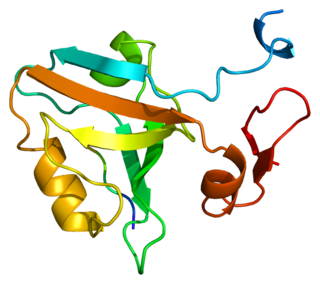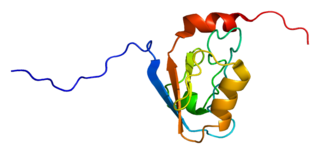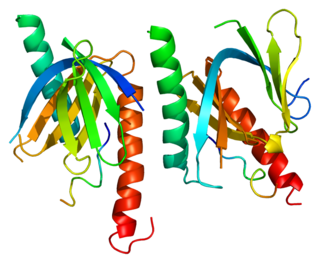Semaphorin-4C is a protein that in humans is encoded by the SEMA4C gene. [5] [6]
Semaphorin-4C is a protein that in humans is encoded by the SEMA4C gene. [5] [6]

Erbb2 interacting protein (ERBB2IP), also known as erbin, is a protein which in humans is encoded by the ERBB2IP gene. Discovered in 1997, erbin is a 200kDa protein containing a PDZ domain.

PSD-95 also known as SAP-90 is a protein that in humans is encoded by the DLG4 gene.

Disks large homolog 3 (DLG3) also known as neuroendocrine-DLG or synapse-associated protein 102 (SAP-102) is a protein that in humans is encoded by the DLG3 gene. DLG3 is a member of the membrane-associated guanylate kinase (MAGUK) superfamily of proteins.

Serine/threonine-protein kinase N1 is an enzyme that in humans is encoded by the PKN1 gene.

GIPC PDZ domain containing family, member 1 (GIPC1) is a protein that in humans is encoded by the GIPC1 gene. GIPC was originally identified as it binds specifically to the C terminus of RGS-GAIP, a protein involved in the regulation of G protein signaling. GIPC is an acronym for "GAIP Interacting Protein C-terminus". RGS proteins are "Regulators of G protein Signaling" and RGS-GAIP is a "GTPase Activator protein for Gαi/Gαq", which are two major subtypes of Gα proteins. The human GIPC1 molecule is 333 amino acids or about 36 kDa in molecular size and consists of a central PDZ domain, a compact protein module which mediates specific protein-protein interactions. The RGS-GAIP protein interacts with this domain and many other proteins interact here or at other parts of the GIPC1 molecule. As a result, GIPC1 was independently discovered by several other groups and has a variety of alternate names, including synectin, C19orf3, RGS19IP1 and others. The GIPC1 gene family in mammals consisting of three members, so the first discovered, originally named GIPC, is now generally called GIPC1, with the other two being named GIPC2 and GIPC3. The three human proteins are about 60% identical in protein sequence. GIPC1 has been shown to interact with a variety of other receptor and cytoskeletal proteins including the GLUT1 receptor, ACTN1, KIF1B, MYO6, PLEKHG5, SDC4/syndecan-4, SEMA4C/semaphorin-4 and HTLV-I Tax. The general function of GIPC family proteins therefore appears to be mediating specific interactions between proteins involved in G protein signaling and membrane translocation.

Amyloid beta A4 precursor protein-binding family A member 1 is a protein that in humans is encoded by the APBA1 gene.

Semaphorin-4D (SEMA4D) also known as Cluster of Differentiation 100 (CD100), is a protein of the semaphorin family that in humans is encoded by the SEMA4D gene.

Plexin B1 is a protein of the plexin family that in humans is encoded by the PLXNB1 gene.

Ena/VASP-like protein is a member of the Ena/VASP family of proteins that in humans is encoded by the EVL gene.

Semaphorin-3F is a protein that in humans is encoded by the SEMA3F gene.

Disks large-associated protein 1 (DAP-1), also known as guanylate kinase-associated protein (GKAP), is a protein that in humans is encoded by the DLGAP1 gene. DAP-1 is known to be highly enriched in synaptosomal preparations of the brain, and present in the post-synaptic density.

Plexin-A1 is a protein that in humans is encoded by the PLXNA1 gene.

Disks large-associated protein 2 is a protein that in humans is encoded by the DLGAP2 gene.

Leucine rich repeat containing 7 also known as LRRC7, Densin-180, or LAP1 is a protein which in humans is encoded by the LRRC7 gene.

Semaphorin 7A, GPI membrane anchor (SEMA7A) also known as CD108, is a human gene.

Cysteine-rich PDZ-binding protein is a protein that in humans is encoded by the CRIPT gene.

Receptor-type tyrosine-protein phosphatase H is an enzyme that in humans is encoded by the PTPRH gene.

Semaphorin-6C is a protein that in humans is encoded by the SEMA6C gene.

Neurochondrin is a protein that in humans is encoded by the NCDN gene.

Semaphorin-6A is a protein that in humans is encoded by the SEMA6A gene.